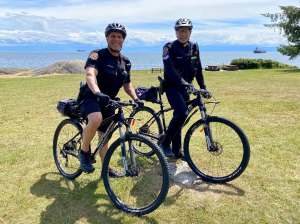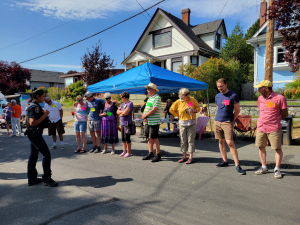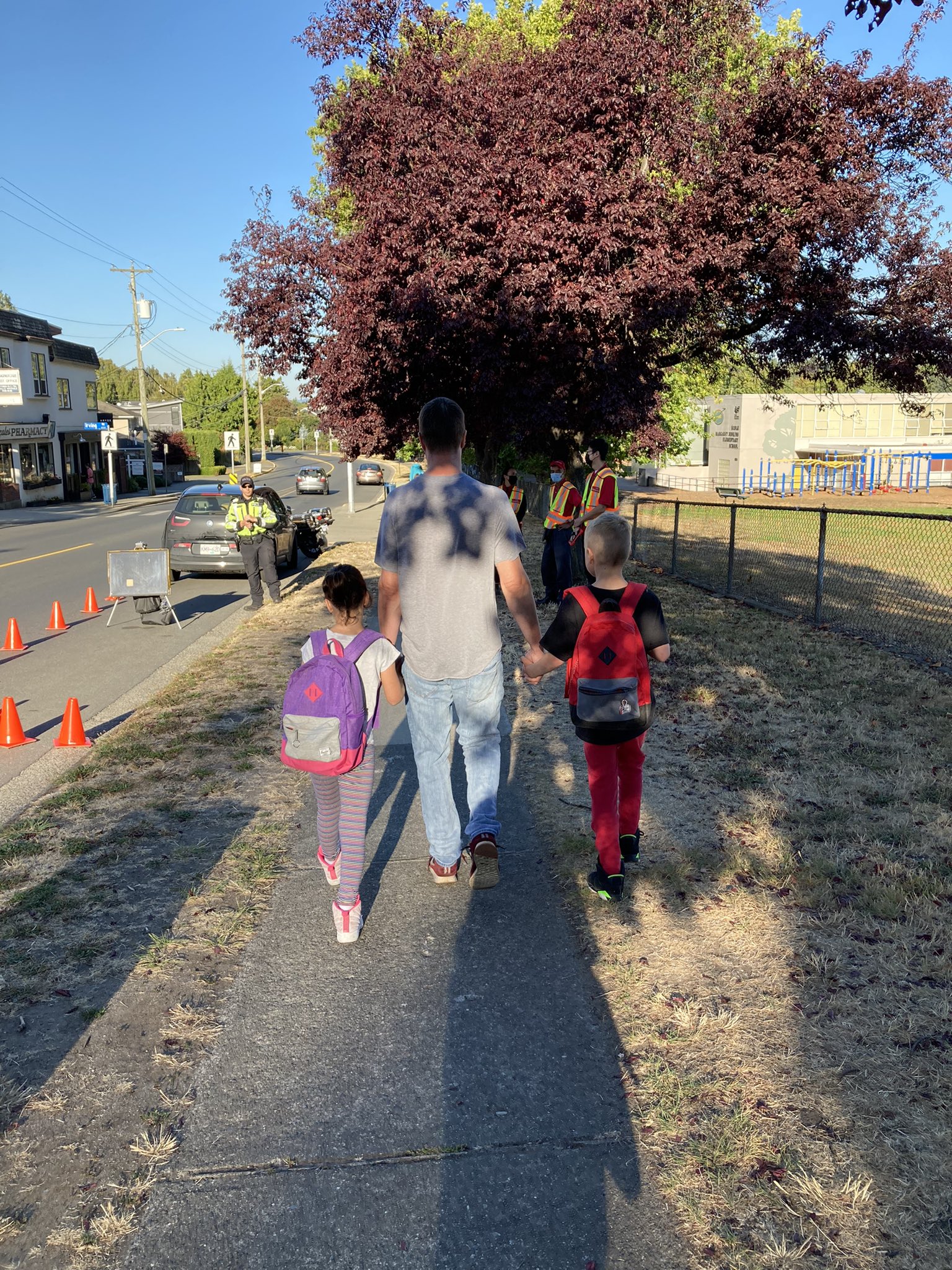 Township of Esquimalt: 2021 – Q3
Township of Esquimalt: 2021 – Q3
As part of our ongoing Open VicPD transparency initiative, we introduced Community Safety Report Cards as a way to keep everyone up to date with how the Victoria Police Department is serving the public. These report cards, which are published quarterly in two community-specific versions (one for Esquimalt and one for Victoria), offer both quantitative and qualitative information about crime trends, operational incidents, and community engagement initiatives. It is hoped that, through this proactive sharing of information, our citizens have a better understanding of how VicPD is working toward its strategic vision of “A Safer Community Together.”
Description
Charts (Esquimalt)
Calls for Service (Esquimalt)
Call for Service (CFS) are requests for services from, or reports to the police department that generate any action on the part of the police department or partner agency performing work on behalf of the police department (such as E-Comm 9-1-1).
CFS include recording a crime/incident for reporting purposes. CFS are not generated for proactive activities unless the officer generates a specific CFS report.
The types of CFS are broken into six main categories as follows:
- Social order – call types include disturbance, man down, unwanted person, etc.
- Violence – call types include assault, sexual assault, robbery, etc.
- Property – call types include break and enters, theft from vehicles, theft of vehicles, etc.
- Traffic – call types include collision response, impaired driving and other traffic offences.
- Assist – call types include requests to assist BC Emergency Health Services paramedics, Parole, other police departments, etc.
- Other – calls are those which do not fit into the categories above.
Annual trends show a decrease in total CFS in 2019 and 2020. Since January 2019, abandoned calls, which are included in the total number of calls and can often generate a police response, are no longer captured by the E-Comm 911/Police Dispatch Centre in the same way. This has significantly reduced the total number of CFS. Also, policy changes with regard to abandoned 911 calls from cell phones occurred in July 2019, further reducing these CFS totals. Additional factors that have reduced the number of 911 calls include increased education and changes to cell phone design so that emergency calls could no longer be activated by a one-button push.
These important changes are reflected in the following abandoned 911 call figures, which are included in the displayed CFS totals and are largely responsible for the recent decrease in total CFS:
2016 = 8,409
2017 = 7,576
2018 = 8,554
2019 = 4,411
2020 = 1,296
Esquimalt Calls for Service – By Category, Quarterly

Source: VicPD
Esquimalt Calls for Service – By Category, Annually

Source: VicPD
VicPD Jurisdiction Calls for Service – Quarterly

Source: VicPD
VicPD Jurisdiction Calls for Service – Annually

Source: VicPD
Crime Incidents – VicPD Jurisdiction
Number of Crime Incidents (VicPD Jurisdiction)
- Violent Crime Incidents
- Property Crime Incidents
- Other Crime Incidents
These charts reflect the most available data from Statistics Canada. The charts will be updated when new data is available.
Crime Incidents – VicPD Jurisdiction

Source: Statistics Canada
Response Time (Esquimalt)
Response time is defined as the time that elapses between the time a call is received to the time the first officer arrives on scene.
Charts reflect median response times for the following Priority One and Priority Two calls in Esquimalt.
Response Time – Esquimalt

Source: VicPD
NOTE: Times are displayed in minutes and second. For example, “8.48” indicates 8 minutes and 48 seconds.
Crime Rate (Esquimalt)
The crime rate, as published by Statistics Canada, is the number of Criminal Code violations (excluding traffic offences) per 100,000 population.
- Total Crime (excluding traffic)
- Violent Crime
- Property Crime
- Other Crime
Data Updated | For all data up to and including 2019, Statistics Canada reported VicPD’s data for its combined jurisdiction of Victoria and Esquimalt. Beginning in 2020, StatsCan is separating that data for both communities. Therefore, the charts for 2020 do not display data for past years as direct comparisons are not possible with this change of methodology. As data is added over successive years, however, year-to-year trends will be displayed.
These charts reflect the most available data from Statistics Canada. The charts will be updated when new data is available.
Crime Rate – Esquimalt

Source: Statistics Canada
Crime Severity Index (Esquimalt & Victoria)
The crime severity index (CSI), as published by Statistics Canada, measures both the volume and severity of police-reported crime in Canada. In the index, all crimes are assigned a weight by Statistics Canada based on their seriousness. The level of seriousness is based on actual sentences handed down by the courts in all provinces and territories.
This chart shows the CSI for all municipal police services in BC as well as the provincial average for all police services. For VicPD’s jurisdiction, the CSI for the City of Victoria and the Township of Esquimalt are shown separately, which is a feature that was first introduced with the release of 2020 data. For historic CSI figures that show combined CSI data for VicPD’s jurisdiction of both Victoria and Esquimalt, click here VicPD 2019 Crime Severity Index (CSI).
These charts reflect the most available data from Statistics Canada. The charts will be updated when new data is available.
Crime Severity Index – Esquimalt & Victoria

Source: Statistics Canada
Crime Severity Index (Non-Violent) – Esquimalt & Victoria

Source: Statistics Canada
Crime Severity Index (Violent) – Esquimalt & Victoria

Source: Statistics Canada
Weighted Clearance Rate (Esquimalt)
Clearance rates represent the proportion of criminal incidents solved by the police.
Data Updated | For all data up to and including 2019, Statistics Canada reported VicPD’s data for its combined jurisdiction of Victoria and Esquimalt. Beginning in 2020 data, StatsCan is separating that data for both communities. Therefore, the charts for 2020 do not display data for past years as direct comparisons are not possible with this change of methodology. As data is added over successive years, however, year-to-year trends will be displayed.
These charts reflect the most available data from Statistics Canada. The charts will be updated when new data is available.
Weighted Clearance Rate (Esquimalt)

Source: Statistics Canada
Perception of Crime (Esquimalt)
Community and business survey data from 2021 as well as past community surveys: “Do you think that crime in Esquimalt has increased, decreased or remained the same during the last 5 years?”
Perception of Crime (Esquimalt)

Source: VicPD
Block Watch (Esquimalt)
This chart shows the numbers of active blocks in the VicPD Block Watch program.
Block Watch – Esquimalt

Source: VicPD
Public Satisfaction (Esquimalt)
Public satisfaction with VicPD (community and business survey data from 2021 as well as past community surveys): “Overall, how satisfied are you with the work of the Victoria Police?”
Public Satisfaction – Esquimalt

Source: VicPD
Perception of Accountability (Esquimalt)
Perception of accountability of VicPD officers from community and business survey data from 2021 as well as past community surveys: “Based on your own personal experience, or what you may have read or heard, please indicate whether you agree or disagree that the Victoria Police is accountable.”
Perception of Accountability – Esquimalt

Source: VicPD
Documents Released to the Public
These charts show the number of community updates (news releases) and reports published, as well the number of Freedom of Information (FOI) requests that are released.
Documents Released to the Public

Source: VicPD
FOI Documents Released

Source: VicPD
Overtime Costs (VicPD)
- Investigation and specialized units (This includes investigations, specialized units, protests and other)
- Staff shortage (Cost associated with replacing absent staff, normally for last minute injury or illness)
- Statutory holiday (Mandatory overtime costs for staff working Statutory Holidays)
- Recovered (This is related to special duties and overtime for seconded specialty units where all costs are recovered from outside funding resulting in no additional cost to VicPD)
Overtime Costs (VicPD) in dollars ($)

Source: VicPD
Public Safety Campaigns (VicPD)
The number of public safety campaigns initiated by VicPD and those local, regional, or national campaigns supported by, but not necessarily initiated by VicPD.
Public Safety Campaigns (VicPD)

Source: VicPD
Police Act Complaints (VicPD)
Total files opened by the Professional Standards office. Open files do not necessarily result in an investigation of any type. (Source: Office of the Police Complaints Commissioner)
- Admissible registered complaints (complaints resulting in a formal Police Act investigation)
- Number of reported substantiated investigations (Police Act investigations that resulted in one or more counts of misconduct being established)
Police Act Complaints (VicPD)

Source: Office of the Police Complaint Commissioner of BC
NOTE: Dates below are provincial government fiscal year (April 1 to March 31) i.e. “2019” indicates April 1, 2019 to March 31, 2020.
Case Load per Officer (VicPD)
The average number of criminal files assigned to each officer. The average is calculated by dividing the total number of files by the authorized strength of the police Department (Source: Police Resources in BC, Province of British Columbia).
This chart reflects the latest data available. The charts will be updated when new data is available.
Case Load per Officer (VicPD)

Source: Police Resources in BC
Time Loss in Shifts (VicPD)
VicPD’s operational effectiveness can be, and has been, affected by having employees unable to work. The loss of time recorded in this chart includes both physical and mental health injuries which occur in the workplace. This does not include time lost for off-duty injury or illness, parental leave, or leaves of absence. This chart shows this time loss in terms of shifts lost by both officers and civilian employees by calendar year.
Time Loss in Shifts (VicPD)

Source: VicPD
Deployable Officers (% of total strength)
This is the percentage of officers who are fully deployable to policing duties with no restrictions.
Please note: This is a Point-in-Time calculation each year, as the actual number fluctuates widely throughout the year.
Deployable Officers (% of total strength)

Source: VicPD
Volunteer / Reserve Constable Hours (VicPD)
This is the number of volunteer hours annually performed by volunteers and Reserve Constables.
Volunteer / Reserve Constable Hours (VicPD)

Source: VicPD
Training Hours per Officer (VicPD)
Average training hours is calculated by the total number of hours of training divided by the authorized strength. All training is accounted for including training related to specialized positions such as the Emergency Response Team, and off-duty training required under the Collective Agreement.
Training Hours per Officer (VicPD)

Source: VicPD







